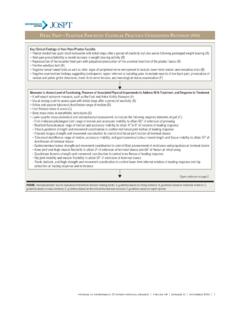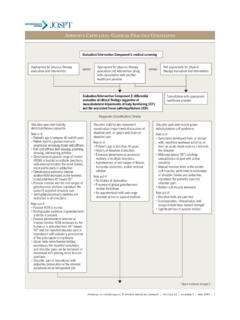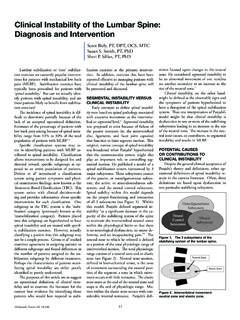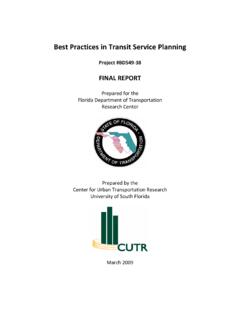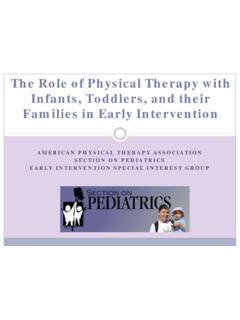Transcription of CURRENT CONCEPTS IN FUNCTIONAL CAPACITY …
1 CURRENT CONCEPTS IN FUNCTIONAL CAPACITY EVALUATION: A Best Practices Guideline (Adopted April 30, 2018). Steve Allison, , DPT, MHS; Jill Galper, PT, MEd.;. David Hoyle, PT, DPT, MA; Jim Mecham, OTR/L, MS. Intent and Scope The primary intent of this document is to provide guidelines for the proper design, administration, and interpretation of FUNCTIONAL CAPACITY Evaluations (FCEs), and to recommend qualification standards for FUNCTIONAL CAPACITY Examiners (Examiner) in order to promote clinical excellence, accountability, and consistency. This document is not meant to be part of the Clinical Practice Guidelines of the Orthopaedic Section of the American Physical Therapy Association, part of the Occupational Therapy Practice Framework: Domain & Process of the American Occupational Therapy Association, or meet specific criteria to be included in the National Guideline Clearinghouse.
2 This document is meant to serve as a primary resource for clinicians who perform FCEs, and for consumers of FCEs including physicians, adjusters, case managers, vocational rehabilitation counselors, and attorneys practicing in workers compensation and disability management. The recommendations contained in this document were developed by a panel with expertise in the design, administration, and interpretation of FUNCTIONAL CAPACITY Evaluations. The expert panel relied on available literature and clinical experience to arrive at these guidelines. The guidelines were reviewed by stakeholders including physical therapists, occupational therapists, and physicians who either have expertise in FCEs as researchers or examiners or who use the results of FCEs in the administration of workers' compensation or disability claims.
3 The reviewers' comments were considered and incorporated into the guideline as deemed appropriate by the expert panel. Readers of this document should understand that the reviewers'. participation in the development of this document does not constitute their endorsement of the final product. The guideline is provided as CURRENT best practice as opposed to standards of practice. An Examiner may deviate from these FCE guidelines when necessary and appropriate in the course of using independent and judicious clinical reasoning in an effort to provide the best information possible as to the FUNCTIONAL abilities and limitations of the individual being evaluated in light of the questions posed by the referral source(s). This document is intended to be used in conjunction with the most CURRENT versions of the apta .
4 Standards of Practice for Physical Therapy1, the apta guide to Physical Therapist Practice, the AOTA Occupational Therapy Practice Framework: Domain & Process2, and the International Classification of Functioning, Disability and Health3. Examiners should have a full understanding of potential limitations of FCEs which include but are not limited to issues related to validity and reliability (test selection and individual CURRENT CONCEPTS in FUNCTIONAL CAPACITY Evaluation: A Best Practices Guideline Adopted April 30, 2018 Page 1 of 43. performance), the influence of an individual's behavior and symptoms on overall test results, Examiner bias, and standardization of testing and reporting. A Glossary of terms commonly used in FCEs has been developed as part of the guideline.
5 Please refer to the Glossary for definitions of the terms used in this document. Introduction A FUNCTIONAL CAPACITY Evaluation (FCE) is a comprehensive performance-based medical assessment of an individual's physical and/or cognitive abilities to safely participate in work and other major life The four major components of an FCE include4-7: 1. Intake interview 2. Medical records review 3. Physical examination 4. Content valid FUNCTIONAL testing. An FCE attempts to identify an individual's ability to safely participate in work and other major life activities. In instances where an individual has an illness, medical condition, or disorder that impairs his/her ability to safely participate in work or other major life activities, FUNCTIONAL limitations may be present.
6 Residual FUNCTIONAL CAPACITY represents what an individual can still do despite FUNCTIONAL limitations resulting from a medically determinable impairment(s) and impairment-related symptoms. In determining an individual's residual FUNCTIONAL CAPACITY , FUNCTIONAL CAPACITY Examiners should rely on objective clinical measurements and observations during content valid FUNCTIONAL testing in combination with objective evidence gathered from a physical examination and a review of medical records. FUNCTIONAL CAPACITY Examiners should also consider subjective evidence from the individual's self-reported pain and disability reports, which may include standardized questionnaires as well as subjective information provided by the individual through an interview as part of the Historically, return-to-work decisions were based upon diagnoses and prognoses of physicians, but did not include objective measurements of an individual's FUNCTIONAL abilities.
7 Most physicians are not trained to assess the full array of human FUNCTIONAL abilities required for comprehensive disability determinations9 or return to work recommendations. The physician or treating provider determines diagnosis and medical prognosis, but should rely on FUNCTIONAL testing to more objectively identify an individual's FUNCTIONAL abilities and limitations rather than their use of estimates, commonly called In an evidence-based medical model, measurements are preferable to ,11. Medically determinable impairments combined with the results from content valid FUNCTIONAL testing administered by qualified FUNCTIONAL CAPACITY Examiners form the basis for establishing the severity of FUNCTIONAL limitations and FUNCTIONAL ,13.
8 CURRENT CONCEPTS in FUNCTIONAL CAPACITY Evaluation: A Best Practices Guideline Adopted April 30, 2018 Page 2 of 43. FCE Utilization FCEs are routinely utilized in cases involving workers' compensation, personal injury, long term disability, and Social Security Disability claims to determine an individual's ability to safely participate in work and other major life activities. FCEs are commonly requested by physicians, attorneys, insurance claims adjusters, medical case managers, employers, and vocational rehab counselors. Individuals with self-reported activity limitations may also request an FCE to provide objective documentation of their ability to safely participate in work and other major life activities. Frequent indications for an FCE include, but are not limited to, the following: 1.
9 FUNCTIONAL testing performed as part of the work rehabilitation process such as safe entrance into an advanced work rehabilitation program. This may involve the Examiner selecting the most relevant tests for gap analysis between the individual's safe abilities and the job demands. The results are used for program development, to assess progress during the episode of care and as the basis for work recommendations and accommodations, if appropriate. 2. The individual has been participating in ongoing treatment and performance measures used during treatment may be used in combination with further testing to reach conclusions about the individual's ability to safely participate in work and other life activities during their recovery.
10 3. The individual has reached maximum rehabilitation potential. CURRENT physical and/or cognitive abilities are requested to assist with claim closure. 4. The individual is working, but difficulty performing job tasks has been reported or observed. A job specific FCE should clearly identify whether there are gaps between safe FUNCTIONAL abilities and job demands. 5. Healthcare provider's report that there is a discrepancy between the individual's subjective complaints and objective findings, and the FCE is requested to identify the individual's level of participation, consistency, and behaviors during the evaluation. 6. Physical and/or cognitive abilities data are needed for case management, disability determination, determination of loss of earning CAPACITY , litigation settlement, or case resolution.


